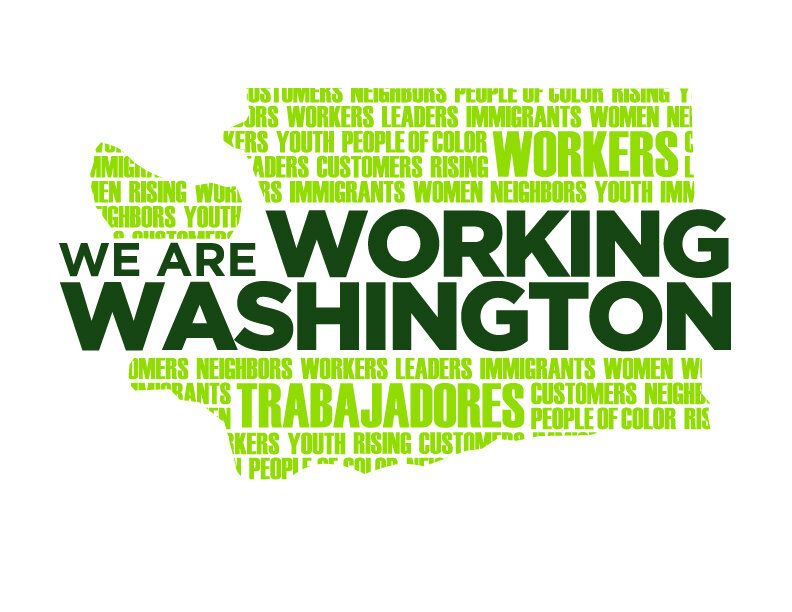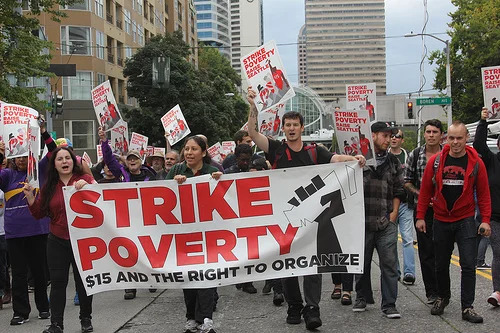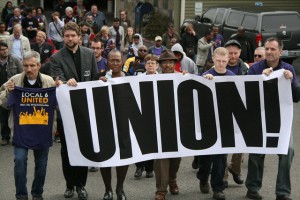1. Does higher pay mean fewer jobs?
No. According to numerous studies, raising the minimum wage shows little negative impact on the number of jobs[1]. This may surprise you if you’re used to trickle-down economics, but the data shows that when wages are raised in a broad manner the workers use that increase in wages to increase demand for consumer goods.
Nick Hanauer, a multi-millionaire venture capitalist, wrote about the need to raise the minimum wage to $15 an hour in Bloomberg.
“Raising the minimum wage to $15 an hour would inject about $450 billion into the economy each year. That would give more purchasing power to millions of poor and lower-middle-class Americans, and would stimulate buying, production and hiring.
Raising the earnings of all American workers would provide all businesses with more customers with more to spend.[2]”
2. These jobs are supposed to be stepping stones, not careers.
The economy has changed and the fastest growing jobs are fast food and service jobs that pay poverty wages[3]. Regardless of what you think these jobs are “meant to be,” the people working these jobs deserve better than poverty wages and they should have the right to organize without retaliation.
Even though Washington State has the highest state minimum wage in the country, you can’t afford to support yourself on $9 and change — let alone put money aside to reach out to a better future.
3. I worked my way up why can’t they?
These fast food and service jobs are the fastest growing jobs, and they offer few opportunities. Almost 90% of jobs in fast food are front-line poverty-wage jobs[4], so it’s simply not possible for most people to “work their way up” in the field. And despite the fairytales about starting out on the fryer and eventually owning a franchise, the cost of opening a fast-food outlet is incredibly high[5], and far out of reach for a minimum-wage employee:
For example, if you aspire to open a McDonald’s outlet:
To be considered for a franchise, a minimum of $750,000 of personal funds is normally required. This amount has to be yours – it can't be borrowed, such as by way of a credit line.
A prospective franchisee must put at least 25% cash as a down payment toward the total cost of purchasing an existing restaurant. The remainder can be financed, but for a maximum of seven years. For a new restaurant, McDonald's requires 40% of the entire cost of the store be paid in cash at the outset.
Equipment and pre-opening costs for a new store generally run from $959,450 to $2.11 million.
Franchisees pay a service fee based on the restaurant’s sales. Currently, that's set at 4% of monthly sales, along with rent that's due.
In order to open a new restaurant, a $45,000 initial franchise fee is paid to McDonald's.
The numbers for Burger King are similar:
The total investment needed to begin operating a restaurant will range from around $316,100 to $2.66 million.
Starting costs include a $50,000 initial franchise fee (it can be less when the term of the franchise agreement is under 20 years).
To qualify as a franchisee, you need net worth of $1.5 million and $500,000 in liquid assets.
Royalties are currently a monthly fee of 4.5% of gross sales.A monthly advertising contribution of 4% of gross sales is also collected by the corporate parent.
And Wendy’s?:
Getting in on Wendy's (WEN), which is selling more of its company-owned stores to franchisees, is extremely difficult. Currently, it's only accepting applications for prospective franchisees who want and can afford to open or buy multiple stores. Applications aren't being taken for single new restaurant owners. (Large operators aren't uncommon in the restaurant industry. One of the biggest, NPC International, owns more than 1,000 restaurants, including Wendy's stores.)
You must have net worth of at least $5 million. This could include liquid assets, retirement accounts or real estate, among other holdings.
Liquid assets of at least $2 million are required.
4. Giving people better pay in these jobs would make them give up their dreams.
When workers earn more money they can afford to go back to school, put money away and plan for their future. Getting livable wages frees them from the paycheck to paycheck mentality and lets them have a path to move towards their dreams.
5. Won’t this drive business out of our city/county/state?
All signs point to no. Minimum wages already vary from state to state by as much as $2 an hour and businesses don’t decide which state they will operate in solely on the basis of the wage differences. In fact, the dollar menu costs the same $1 in states that have a $7.25 minimum wage as it does here in Washington.
Here in Washington State there are fast food outlets right on the border with Idaho. Idaho has a much lower minimum wage of $7.25, compared to the $9.19 in Washington State, yet a McDonald’s franchisee recently told KPLU radio he didn’t even consider moving his restaurant 20 feet across the street into Idaho when he rebuilt recently[6]. Why? He had a good location that generated strong demand.
Another local example would be in Vancouver, WA where due to our state’s sales tax, prices are about 9% higher than they would be in Oregon. Not to mention the minimum wage is higher in Washington State. Yet, plenty of fast food outlets make Vancouver their home, instead of the lower cost state right across the river. Why? Because there’s demand for fast food close to home in Vancouver.
There are numerous elements that make a business succeed or fail. Labor costs are one factor, but only one. Businesses will locate where there is enough demand to operate successfully, and higher wages increase demand[7].
Here’s another example. In 2007 the minimum wage in Washington was 54% higher than nearby Idaho, and the usual suspects all said it would mean doom for small businesses. The New York Times reported on what really happened:
“Nearly a decade ago, when voters in Washington approved a measure that would give the state’s lowest-paid workers a raise nearly every year, many business leaders predicted that small towns on this side of the state line would suffer.
But instead of shriveling up, small-business owners in Washington say they have prospered far beyond their expectations. In fact, as a significant increase in the national minimum wage heads toward law, businesses here at the dividing line between two economies — a real-life laboratory for the debate — have found that raising prices to compensate for higher wages does not necessarily lead to losses in jobs and profits."[8]
This is all evidence backing up a study on the effect of minimum wage increases on restaurant employment:
Bill Lester of the University of North Carolina-Chapel Hill was on the team that looked at 16 years worth of restaurant employment data for 316 pairs of border counties.
“And when you add up all those comparisons and look at the average of all those differences in employment, the difference is zero,” said Lester.
Or, to put it another way: When the minimum wage increases, said Lester,“On aggregate, there's no job losses.”
6. The minimum wage wasn’t meant to be a living wage, right?
The fastest growing jobs pay poverty wages. A majority of the jobs created since the recession, 58% are low paying jobs[9]. Like it or not, these are the jobs that are being created. If we want to kick start this economy, we need to make sure people are paid enough so they can support themselves, afford the basics, and spend money.
7. Won’t raising the wages raise the prices?
Let’s get beyond cartoon economics here. Pricing depends on a lot of factors besides labor costs, including rent, demand, turnover, efficiency, food costs, and consumers’ willingness to pay.
That’s why a recent study by Federal Reserve economists has estimated that for every 10% increase in wages, about a 1% increase in costs could be passed on to the consumer. That means a 60% wage increase could increase prices by a measly 6%.[10]
So even if despite their billions in profits, McDonald’s decided to pass on the whole increase to consumers, a Big Mac could go from the average price of $4.56 to a whopping $4.81. Not such a big deal.
And that’s a worst case scenario. Recent studies have actually calculated that raising the minimum wage would drive up demand for consumer goods as workers who are on the lower end of wages tend to spend more of the money they receive as increased wages[11].
Also, the minimum wage across the United States varies from state to state sometimes by as much as $2, but the prices of everyday items is virtually the same[12].
8. Fast food jobs aren’t meant to be good jobs.
Regardless of what you think a job is “meant” to be, these are the jobs that people have. Fast food workers are almost all adults with bills to pay, and many of them have families to support[13].
These are not jobs for pocket change or summer spending money. These are jobs that people are tying to support themselves on.
9. Robots will take away your jobs, then you’ll be sorry.
Michael Reich, coauthor of a study by the National Employment Law Project told Slate Magazine,
“Technology has been increasing restaurant productivity for some time—think of computerized ordering of supplies, Open Table and Yelp and electronic ovens—but that has not translated into lower employment in the aggregate. Indeed, employment in restaurants has been growing along with the use of technology[14].”
The facts of the matter are that these poverty wage jobs are the fastest growing jobs in our economy. Thousands of low paying jobs were created here in Washington State during the recovery and fear of far off, potential robot overlords should not be an excuse to keep worker pay so low they cannot afford their basic needs.
10. Where did the number $15 come from anyway? Why not $25 or $100?
$15 is a number that reflects a wage that will allow a person to pay their bills and obligations and still have some money left over to plan for their future. It works out to be around $30,000/year, a decent wage that sits right at about half of the median income level in the Seattle area[15].
$9.19 is obviously not enough and $100 is obviously a joke — you can’t support yourself on the current minimum, and of course you can’t set the minimum above the median income. So the answer is somewhere in between — and we think $15 is a good place to start.
In Seattle, for a full-time worker to afford a studio apartment using 33% of their income (the recommended amount to spend on housing) they would need to be paid about $15/hour. For a 1-bedroom? More than $21.
That’s why we think $15 an hour is a modest start that will have a real, positive effect on workers. This movement is about workers getting paid a decent, living wage and the community pushing for a much needed economic boost. When low wage earners are paid more, they go out and spend it. The money is pushed out into the community lifting everyone up. That’s basic fairness and economic stimulus.
[1] http://www.igmchicago.org/igm-economic-experts-panel/poll-results?SurveyID=SV_br0IEq5a9E77NMV
[2] http://www.bloomberg.com/news/2013-06-19/the-capitalist-s-case-for-a-15-minimum-wage.html
[3] http://www.nelp.org/page/-/Job_Creation/LowWageRecovery2012.pdf?nocdn=1
[4] http://www.huffingtonpost.com/2013/07/25/fast-food-industry-mobility-_n_3645415.html
[5] http://finance.yahoo.com/news/what-it-takes-to-start-a-fast-food-franchise-222831956.html
[6] http://www.kplu.org/post/why-wont-mcdonalds-move-20-feet-lower-wage-idaho
[7] http://www.nytimes.com/2007/01/11/us/11minimum.html?pagewanted=all&_r=0
[8] http://www.nytimes.com/2007/01/11/us/11minimum.html?pagewanted=all&_r=0
[9] http://www.nelp.org/index.php/content/content_about_us/tracking_the_recovery_after_the_great_recession
[10] http://www.epionline.org/studies/aaronson_06-2006.pdf
[11] http://www.chicagofed.org/digital_assets/publications/working_papers/2007/wp2007_23.pdf
[12] http://www.nytimes.com/2007/01/11/us/11minimum.html?hp&ex=1168578000&en=bf304392cdc5baf4&ei=5094&partner=homepage&_r=0
[13] http://www.cleveland.com/business/index.ssf/2013/08/fast-food_workers_more_often_a.html
[14] http://motherboard.vice.com/blog/relax-a-minimum-wage-hike-wont-bring-on-the-robot-overlords
[15] http://www.kingcounty.gov/exec/PSB/BenchmarkProgram/Economy/EC02_Income.aspx














